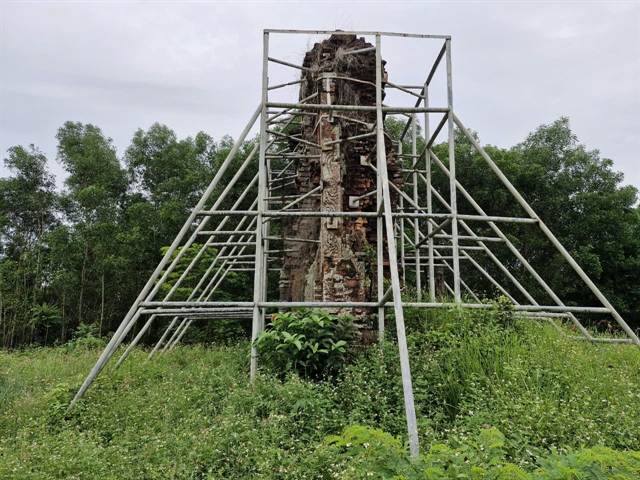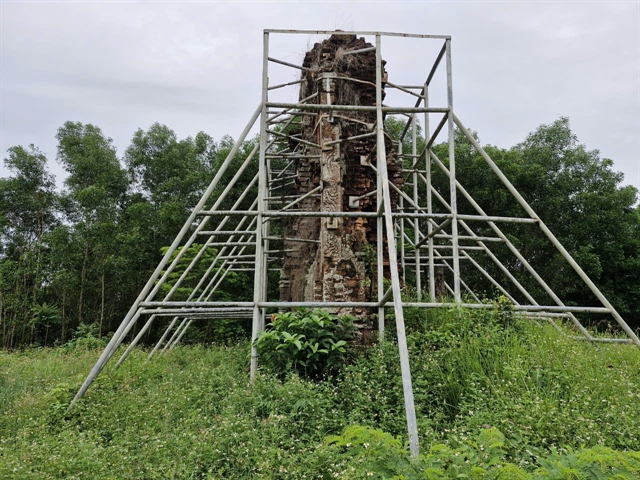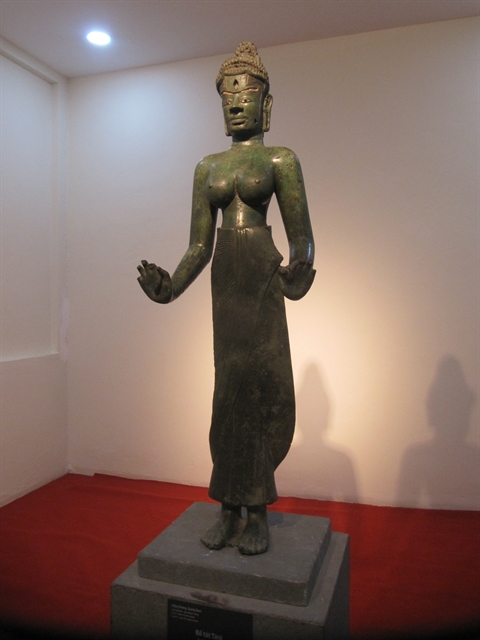
Bright Gate of Đồng Dương Buddhism monastery in Thăng Bình district in Quảng Nam Province receives steel structure supports from falling. The Chăm architecture tower complex has been in ruined for years, and it needs an urgent restoration plan. Photo courtesy of Nguyễn Cường
QUẢNG NAM — The central province of Quảng Nam has called for an emergency restoration plan to save the ruins of the Đồng Dương Buddhist monastery, a tower complex and pedestal altar built by the ancient kingdom of Champa, from complete collapse.
The monastery, which was built in 875 by King Indravarman II of the Champa kingdom, is located in Bình Định Bắc commune, Thăng Bình district. It was a temple where Buddha Laskmindra Lookesvara Svabhayada was worshipped to protect the kingdom.
Now, the ancient architecture has been damaged by centuries of erosion and the impacts of war. Only the Tháp Sáng, or Bright Gate, has been preserved and protected from falling by steel supports.

A wall section of Bright Gate is remained with protection. The item is the only seen at the ruined Đồng Dương Buddhism monastery in Quảng Nam Province. The local authorities have called for an emergency restoration plan for the national relic. Photo courtesy of Nguyễn Cường
Despite its recognition as a National Special Heritage Relic in 2019, the Chăm architecture complex has yet to be granted a Master Plan for full restoration and preservation of all of the towers and relics in the site's ruins.
Director of the provincial department of Culture, Sports and Tourism Nguyễn Thanh Hồng said a detailed plan is needed for different items, including land clearance and compensation for local households and archaeological surveys, excavations and data analysis, for a prolonged preservation project that would cost hundreds of billions of Vietnamese đồng.
“The province has allocated VNĐ15 billion for removal of more than 100 tombs and compensation for household farmers living in the protected area buffer zone,” Hồng said.
“However, any restoration plan or architectural repairs related to the national relic must be approved by the Ministry of Culture, Sports and Tourism. It also needs a huge fund from the State budget to restore the Chăm complex to its original design from previous centuries,” he added.

The Đồng Dương Pedestal, which was excavated at Đồng Dương Buddhism monastery by the French archaeologists from 20th century, is one show at the Chăm Sculpture Museum of Đà Nẵng. VNS Photo Công Thành
Hồng said the only data on the archaeological site and its artefacts was compiled by French research and excavations conducted in the 20th century.
He said land clearance for the site restoration project would begin in 2025.
A report from the Thăng Bình district’s Culture Office noted that before the site was recognised as a National Special Relic, 11 households had built homes and farms and 112 tombs were dug on 5.3ha of the land.
In 2013, six years before it was awarded the national recognition status, the complex's Bright Gate architectural feature was granted VNĐ12 billion to install a steel support structure around the gate to prevent it from falling.
The provincial department said a conference on restoring the ancient site will be scheduled for 2025.
Experts from the Archaeological Survey of India (ASI) have previously visited the temple complex to survey the site and design a restoration plan.
Information from the École française d'Extrême-Orient, or the French School of Asian Studies, reveals that the religious complex was once part of the ancient Champa Kingdom's capital city, called Indrapura. The city was destroyed in wars, but its Bright Gate remains.
French archaeologists excavated the site in the 20th century, and some of the precious artefacts that they found are on display at the Chăm Sculpture Museum in Đà Nẵng.

Statue of Tara/Avalokiteshvara is one of seven National Treasures on display at the Chăm Sculpture Museum of Đà Nẵng. The item was found in Đồng Dương village in Quảng Nam Province. VNS Photo Công Thành
The Statue of Tara/Avalokiteshvara and the Đồng Dương Pedestal are among seven National Treasures that have been preserved and are on display at the Chăm Sculpture Museum in Đà Nẵng.
Quảng Nam is the only province in Việt Nam with two UNESCO - recognised world heritage sites: Mỹ Sơn Sanctuary and Hội An ancient town. The province is also home to the Chàm Islands - Hội An world biosphere reserve site.
The Mỹ Sơn Sanctuary site has been well preserved since it was built thousands of years ago, during a prosperous period for the Champa Kingdom between the 4th and 13th centuries.
The provincial authorities have been working on restoration projects with various organisations including UNESCO and groups from countries like India, Italy and Poland to protect the UNESCO-recognised world heritage site and Chăm tower complexes over the years. —VNS
OVietnam